That is prompting anxiety in the United States about security, coercion and competition
From the snazzy seats of the e14 bus in Montevideo, Uruguay’s capital, it is hard to tell that the smooth electric machine is Chinese. Only an eagle-eyed commuter would spot the tiny window sticker bearing the name of byd, a Chinese manufacturer. Enquiries as to passengers’ concerns about the bus’s Chinese origins elicit bafflement. They are a vast improvement on the deafening gas-guzzlers they replaced. The operator has just ordered 200 more. Thousands of similar buses glide through other Latin cities. But politicians in the United States fret that Latin America’s growing reliance on Chinese green technology, from electric buses to solar panels, is a problem and even a threat.
Tensions are rising because the stakes are high. The fast adoption of green technologies such as electric vehicles (evs), solar panels and batteries is a vital pillar of efforts to halt climate change. These technologies are also an economic smash hit. In 2022 announced foreign direct investment in renewable energy globally totalled over $350bn, dramatically more than annual investments in any other sector not only that year but in decades. That has made green technology the latest front in the United States’ rivalry with China.
Latin America plays an outsize role in this. A world-leading 60% of electricity in the region comes from renewable sources. It boasts a wealth of the critical minerals needed to make green technologies, and is rich enough to be a serious market for them. China so dominates global production of solar panels, batteries and wind turbines that leaders in the United States fear they are losing the green-technology race, both globally and in their backyard. Other developing countries that are trying to go green while balancing Sino-us tensions should be paying attention.
 China is focused on what it calls the “new three”: evs, lithium-ion batteries and solar panels. In 2021 its exports of these products to Latin America already totalled $5bn. They have since almost doubled (see chart 1). Brazil dominates overall, but exports to the wider region are growing even faster. “China’s importance to our market is immense,” says Rodrigo Sauaia of the Brazilian Association of Photovoltaic Energy, an industry body.
China is focused on what it calls the “new three”: evs, lithium-ion batteries and solar panels. In 2021 its exports of these products to Latin America already totalled $5bn. They have since almost doubled (see chart 1). Brazil dominates overall, but exports to the wider region are growing even faster. “China’s importance to our market is immense,” says Rodrigo Sauaia of the Brazilian Association of Photovoltaic Energy, an industry body.
Some 99% of the solar panels imported to Latin America last year were made in China. That is even more than would be suggested by China’s dominant position in solar, where it has 80% of global manufacturing capacity; in wind, that figure is more than 60%. There are more Chinese buses on the streets of Santiago, the capital of Chile, than in any other city outside China.Last year about 70% of evs imported to Latin America were Chinese. And over 90% of the lithium-ion batteries imported to South America were, too.
China’s direct investment in green technology and construction on the continent is surging. Its energy investments suddenly switched to renewables in 2015, according to data crunched by Margaret Myers of the Inter-American Dialogue, a think-tank in Washington (see chart 2). It has ramped up its interest in electricity distribution and transmission. Utility deals worth $17bn accounted for about 75% of Chinese mergers and acquisitions in the past five years in Latin America. State Grid, a state-owned Chinese utility, has bought two of Chile’s largest electricity distributors and serves about half of the country’s market. After a series of acquisitions in Peru, state-owned Chinese companies are set to control the distribution of all electricity in Lima, the capital.
Other green sectors are attracting investment, too. In 2022 Chinese firms invested $2.2bn in the ev industry, 35% of total Chinese fdi in Latin America that year. The bulk of this was in ev- and battery-manufacturing in Brazil, Mexico and Argentina. In Brazil byd has taken over a former Ford factory in the east. (The symbolism is not lost on bigwigs in Washington.) It will be byd’s biggest hub outside Asia, initially producing 150,000 vehicles a year, with the potential to increase that to 300,000. In Mexico byd is planning a factory of a similar size.
Many in Latin America see this as good news. Chinese solar panels and evs are cheap and effective. Any jumpiness about surging imports is balanced by hopes that Chinese investment will lead to more green gear being manufactured locally, boosting jobs and growth. In solar panels that seems doubtful. China is so dominant and the panels so standardised that production will probably stay in China.
 Processing lithium for batteries looks more likely. When in China last year, Gabriel Boric, Chile’s president, announced that Tsingshan, a Chinese metals-processing firm, would invest $233m in a Chilean plant to produce lithium iron phosphate, a compound used to make cheaper batteries. “The most important thing”, he said, is that “we will be creating value chains and transferring knowledge.” Local wind-turbine manufacturing also looks plausible.
Processing lithium for batteries looks more likely. When in China last year, Gabriel Boric, Chile’s president, announced that Tsingshan, a Chinese metals-processing firm, would invest $233m in a Chilean plant to produce lithium iron phosphate, a compound used to make cheaper batteries. “The most important thing”, he said, is that “we will be creating value chains and transferring knowledge.” Local wind-turbine manufacturing also looks plausible.Juicing the joules
The greatest potential for local green manufacturing is in evs, which Brazil is trying to hasten by raising tariffs on imports. byd’s plan to produce 150,000 evs a year in Brazil is a big bet, equivalent to over half of the company’s global exports in 2023 and far more than the 18,000 byd vehicles that Brazil imported that year. But Brazil is a big market, with 2.3m new vehicles registered in 2023. Only 2.5% of those were electric, but that was twice the 2022 figure. That neighbouring Latin American countries are also electrifying their fleets adds to the opportunity.
Evan Ellis of the us Army War College says the stand-off over green technology is a “civilisational struggle”. For the United States that comprises a trio of worries. The first is that Chinese green technology could pose a security threat, to the United States and others. President Joe Biden recently ordered a national-security probe into the risks posed by Chinese green technologies and warned that Chinese evs could be “remotely accessed and/or disabled”. One fear is that they could collect data on sensitive military sites. A more extreme one is that remote access could potentially turn them into weapons.
Such a grim scenario is far-fetched, especially in Latin America. Even if such meddling were technically possible, which is far from clear, any attempt or threat to weaponise evs would do great damage to China’s global car industry. The threat from solar panels or wind farms is even more limited. Solar panels themselves are “dumb”, and do not send data anywhere by default. For connected parts like inverters, though Chinese firms do dominate, there are many other options on the market.
Security does matter to Latin leaders, but in a different sense. “The push for cleaner energy is also a matter of national security,” says Diego Pardow, Chile’s energy minister. Diversified energy partners are important, he agrees. But even if plenty of Chile’s green technology comes from China, slashing reliance on imported gas and oil using Chile’s wind and sun reduces national-security risks because it cuts Chile’s exposure to strife in the Middle East or Ukraine, he explains.
The United States’ second fear is that Latin reliance on Chinese green technology gives China political leverage that it could use to exert pressure on anything from Taiwan to exclusive mining deals. Yet solar panels and wind turbines provide little ongoing leverage once they’re installed. Besides, Latin America boasts some 60% of global lithium resources, a handy green bargaining chip of its own. Leverage can also come from any economic ties, and the United States and Europe are far larger investors in Latin America overall than China. Though China may be moving the fastest on green technology, Europe and the United States are active, too. The biggest renewables project announced in Latin America in 2022 was an aviation-biofuels plant in Panama, which is being built by a firm from the United States. Europe, meanwhile, is hoping for a large role in green hydrogen. For Latin America as a whole, the United States is still the largest trading partner.
Some concerns about political pressure are more reasonable. Chinese ownership of large shares of critical infrastructure, such as electricity-distribution grids in Peru and Chile, is more worrying because the flow of electrons through wires is something that the operating company can easily disrupt. Unlike Europe and the United States, many Latin American countries lack an institution to assess foreign investments on strategic or national-security grounds. Still, says Mr Pardow, most of Chile’s distribution grid used to be owned by one Spanish firm. “We are more diversified than we used to be,” he notes.
Green-tech FOMO
Uncle Sam’s last worry is that firms and workers in Latin America and the United States are losing out to Chinese ones in the world-shaping green-technology industry, thanks to heavy state support in China. In March Janet Yellen, the us treasury secretary, said that Chinese overcapacity in green technologies “hurts American firms and workers, as well as firms and workers around the world”. Officials in Washington fret that a flood of Chinese goods will lead to deindustrialisation not just in Latin America but in every country which remains open to Chinese green-technology imports. The existence of China’s green-technology fdi is evidence against this. At any rate, there are few good Western alternatives to China’s “new three”. If fdi keeps expanding, and local production comes to rival Chinese imports, anxiety about Latin deindustrialisation should ease.
The United States’ concerns about its weakness in green technologies will remain, though. They are understandable, but until its firms can reliably provide cheap, effective and large-scale alternatives to Chinese offerings, urging caution on Latin American leaders will do little good. “Alerting about risks without putting an alternative on paper is not useful at all,” says Thiago de Aragão of Arko Advice, a Brazilian political consultancy. Instead, he says, “it creates antipathy.”







